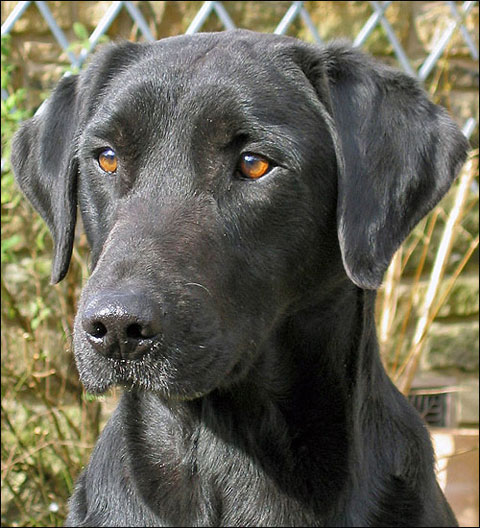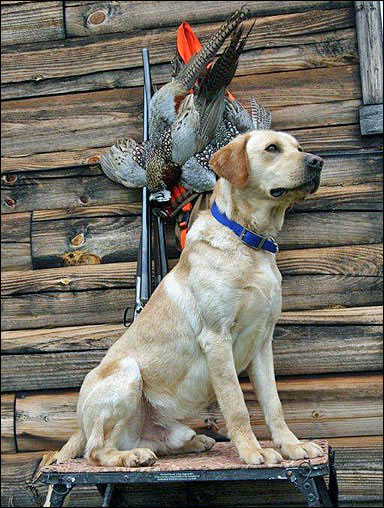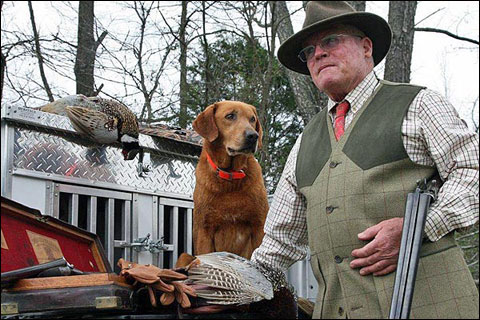Expert Dog Trainer Robert Milner Says Heck No to Shock Collars

Dog trainer extraordinaire Robert Milner wants to ask sportsmen a personal question: Would you discipline your own children with a shock collar?
The case he makes against canine shock collars is audacious and contrarian in the worlds of American bird hunting and field trials – attracting a contingent of detractors during his five decades as a trainer of dogs for hunting, rescue and explosive detection.
 Robert Milner with two of his British Labrador Retriever puppies.
Robert Milner with two of his British Labrador Retriever puppies.
He is supremely confident in his judgment, however, because reams of scientific data conclude that dogs, their owners and trainers benefit more from positive-reinforcement training as adopted by Guide Dogs for the Blind and the Marine Mammal Program developed by the Navy to train dolphins versus widespread compulsion training that implements shock and choke collars to exact pain on a uncooperative dog.
“The sporting culture in this country has a poor concept of a dog’s nature and behavior,” he explained from the sparse office of his Duckhill Kennels in Somerville, Tennessee. “We owe it to them to learn the most effective and gentle ways to train them. We have a responsibility as their mentors to educate ourselves on how they learn and how to best train them. Quite frankly, culturally, we have an absolutely horrible training model.”
It may come as a surprise that from 1965 to 2002 Mr. Milner trained thousands of prized dogs by mastering compulsion training — until September 11, 2001 when al-Qaeda attacked America.
 Indiana is a British Labrador Retriever bred at Robert Milner’s Duckhill Kennels.
Indiana is a British Labrador Retriever bred at Robert Milner’s Duckhill Kennels.
In the aftermath of 9-11, the Federal Emergency Management Agency summoned urban search and response rescue teams from different states to help locate the dead and living among the devastation in New York City, Washington, D.C. and rural Pennsylvania. The teams included rescue workers, engineers, doctors, nurses and four dogs trained to find buried victims and remain at that spot barking until their handlers could verify the discovery.
Tennessee’s Task Force 1 participated in the grim effort at the Pentagon airliner crash site — with results they ultimately considered disappointing. Upon returning home, they called Mr. Milner who had originally trained their dogs and handlers.
Delving into the team’s procedures, he opted to replace the dogs and trainers. He recruited local police and fire fighters as handlers in an effort to instill the first-responder ethos into the revamped program. The dogs were superseded by young Labrador Retrievers. Still, headway remained sluggish.
“Three months into the training cycle I looked at the progress data and determined it would take 18 months to get this team trained,” he recalled. “My reaction was that’s way too long and I needed to get them operational much faster. And I thought it was probably the training model that was the choke point.”
 Robert Milner hunting ducks at the famed Beaver Dam Lake. With him are Tex (left) and Boomer (on bench), a couple of the British Labrador Retrievers from his Duckhill Kennels. [photo: John Hoffman]
Robert Milner hunting ducks at the famed Beaver Dam Lake. With him are Tex (left) and Boomer (on bench), a couple of the British Labrador Retrievers from his Duckhill Kennels. [photo: John Hoffman]
Mr. Milner’s pursuit of a new training method led him to the U.S. Navy’s celebrated Marine Mammal Program. Although started in the early 1960s, its mission evolved during the ensuing decade to train dolphins and sea lions for detecting enemy underwater mines, protect ships and harbors against unauthorized swimmers and recover test equipment. Of particular interest to Mr. Milner was the Navy’s adoption of so-called Operant Conditioning, also known as positive reinforcement, where a correct response is rewarded and a wrong response is ignored — in contrast to zapping a dog with a shock collar or yanking on its choke collar when it refuses to comply.
The Marine Mammal Program was based on the research of renowned behaviorist, B.F. Skinner, who conducted the bulk of his studies at Harvard University. Skinner’s body of work fell under the rubric of Operant Conditioning. Within that framework, his Law of Effect showed positive-reinforcement behavior was more likely to be repeated while behavior that is not reinforced either declined or disappeared.
When it comes to dogs, the most popular form of Operant Conditioning is clicker training. A small clicker noisemaker marks the behavior being reinforced. The clicker is usually complemented by a treat. Both are discontinued after the dog learns the command.
 Robert Milner on Beaver Dam Lake. His British Labrador Retrievers are Tex (left) and Boomer (right). John Hoffman, Photo Editor for Ducks Unlimited, is paddling. Behind his father is Robert Milner, Jr.
Robert Milner on Beaver Dam Lake. His British Labrador Retrievers are Tex (left) and Boomer (right). John Hoffman, Photo Editor for Ducks Unlimited, is paddling. Behind his father is Robert Milner, Jr.
Mr. Milner realized that positive reinforcement could be the solution to his difficulty with Tennessee Task Force 1. He located top clicker trainer, Karen Pryor, who is based in Boston. At the time, she was preparing to conduct a seminar in Tampa, Florida. Mr. Milner wasted no time in booking flights for the entire Tennessee Task Force 1 to attend Ms. Pryor’s sessions.
He subsequently invited two consummate clicker trainers to Tennessee, Steve White and Kathy Sdao, both from Washington state. They worked individually with members of the Tennessee Task Force 1 dog team.
“The end result was I got the dogs and handlers trained in six months instead of 18,” Mr. Milner said of Tennessee Task Force 1. “The lesson I learned from that was the major benefit of positive training is that it’s three times easier for new trainers to learn.”
Deeper research into clicker training supported his initial observations. He referenced statistics from Guide Dogs for the Blind. In 2005, the organization switched from compulsion training to positive reinforcement. He cited that their pass rate on the dogs increased from 50 percent to 80 percent, while training for the blind handlers declined from six week to two weeks — another instance of that 300-percent improvement.
 Tex of Duckhill Kennels.
Tex of Duckhill Kennels.
“That’s when I converted, and I’ve spent the last 10 years developing the principles of Skinner to training gun dogs, explosive detection dogs and rescue dogs,” he said.
From Mr. Milner’s perspective, positive reinforcement-training suits the basic nature of dogs. He believes over the past 15,000 years dogs have been evolving into creatures that make themselves valuable to people. Evolution has driven a continually stronger talent in dogs for reading people and anticipating their wants.
“When you apply a punishment, be it a jerk on the neck with a choke collar or a jolt of electricity from a shock collar, it decreases the preceding behavior and it increases the following behavior because it’s an escape mechanism for the dog,” he elaborated. “So when you zap a dog on the neck, it makes him want to leave and he will run away from that place. You’ve trained him to run away from you.”
With that in mind, the situation deteriorates for most gun dogs, according to Mr. Milner. “If you shock a dog with a bird in his mouth, his neck and jaw muscles contract, which causes him to clamp down or punch holes in the bird. Then the pain goes away. So chomping down on the bird is an escape response because chomping down on the bird turned off the pain.”
As the original owner of the famed Wild Rose Kennels founded in 1972, and influenced by his 26-year military career specializing in disaster response, the retired U.S. Air Force Lieutenant Colonel freely admitted to training thousands of dogs with shock collars. “But that’s not the point,” Mr. Milner emphasized. “The point is we have a responsibility as trainers and sportsmen to learn better ways. Dogs don’t deserve training by punishment.”
 Robert Milner with Boomer.
Robert Milner with Boomer.
Compulsion training is not a function of cruelty, he insisted. Shock collars appear to offer a fast track for the average sportsman who holds down a full-time job while juggling family obligations.
“The shock collar industry has convinced him it’s the quick and easy way to train a dog, and that’s total B.S.,” Mr. Milner observed. “Once again, studies have shown that in fact positive training yields 300-percent faster results at a fraction of the cost. Plus the sportsman ends up with a better dog and a much better relationship with the dog.”
For Mr. Milner, selective breeding can produce dogs amenable to positive-reinforcement training. Once a prominent figure in American field trials, he dropped out of the scene in 1982 after realizing staged challenges typically exaggerated the actual demands of a hunting dog. To win the competitions, owners and handlers propagated hyperactive dogs — and shock collars delivered a quick fix on the invigorated pups.
The same year, he traveled to England in search of British Labrador Retrievers whose temperament he thought more gentle than many American breeds. British field-trial handlers, who bred highly tractable dogs, frowned on shock collars. Because the British Labrador Retriever stock is distinguished by its disposition toward positive training and delivery to hand, trainers trust that their gentle instruction reinforces the dog’s natural tendencies. A dog that is too hot for field-trial preparation is often placed in a new home. Consequently, sporting-dog breeding in England promotes animals favorable toward a positive reinforcement regimen. (The Welsh have virtually mandated positive-reinforcement training by outlawing shock collars. The offense carries a maximum penalty of six months in prison or a £20,000 fine.)
These British Labrador Retrievers made their U.S. debut in 1983 at his Wildrose Kennels stemming from a relationship he established with the late Major Morty Turner-Cooke, a well-recognized British field and gundog trainer and breeder. He now works with Robin Watson of Tibea Gundogs, a noted British Labrador trainer and an A Panel judge for British Retriever Field Trials. Today, Mr. Milner’s Duckhill Kennels is the only American supplier of British Labrador Retriever bitches bred from the original Duke of Buccleuch Oak that dates back to the 1830s.
The 300 dogs he sells annually are selected for their game-finding initiative, calm and pleasant disposition, high intelligence, easy to train and natural delivery to hand.
In Robert Milner’s perfect world, conservation hunting and shooting sports groups would promote the principles of positive training.
“But as long as we remain ignorant about training dogs with positive reinforcement, we can’t make an intelligent decision on it,” he said.
Irwin Greenstein is the Publisher of Shotgun Life. You can reach him at letters@shotgunlife.com.
Useful resources:
www.duckhillkennels.com

Irwin Greenstein is Publisher of Shotgun Life. Please send your comments to letters@shotgunlife.com.


Comments